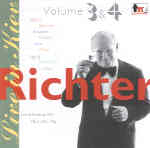Collectors of Sviatoslav Richter’s recordings won’t find “new” repertoire among the 1959/60 performances from Kiev issued here for the first time. On the other hand, these count among the great pianist’s prime years. Just listen to the breathtaking agility and keen timing he brings to Haydn’s last piano sonata. Granted, it’s not so well-recorded as the mid-’60s performance in Philips’ Richter Edition, plus I doubt he launched as quickly into the slow movement as the edited disc suggests. Richter’s freewheeling approach to the Appassionata, familiar via numerous recorded versions, is tempered by more attention than usual to Beethoven’s dynamics and less broadening of the Presto coda’s half-notes. The Schumann and Schubert encores differ little from Richter’s other readings. By contrast, the two Etudes bookending Chopin’s Op. 10 set (No. 1 in C and No. 12 in C minor, the famous “Revolutionary”) are more impassioned and fiery than the pianist’s relatively uneventful live DG traversals from a few years later.
Not one iota of digital prowess and control is sacrificed via Richter’s shockingly fast tempos for the C-sharp minor and A-flat studies. While Richter’s 1971 studio recordings of 13 preludes culled from Rachmaninov’s Op. 23 & 32 are models of suppleness, style, and clarity, his younger counterpart here delivers the goods with additional bellyfire and élan. The Chopin Four Ballades played on March 5, 1960 offer interesting (though not substantial) differences from other Richter readings. I prefer the greater fluidity and accuracy of the March 5th First Ballade to the one from two days earlier that’s also included in this release. The Second Ballade’s lyrical sections offer less sectionalized, more proportioned rubato than the contemporaneous version on BMG/Melodiya (Russian Piano School Vol. 6), but the tumultuous A minor episodes are less well controlled.
I’ve never been convinced by Richter’s seemingly arbitrary tempo speed-ups in the Third Ballade, but at least they seem more purposeful in the pianist’s DG studio traversal than the offhanded impatience I detect here. The Kiev Fourth Ballade essentially offers the 1962 DG and 1960 Praga interpretations in less alluring sonics. Richter treats the recurring theme with great rhythmic freedom, yet each episode seems to grow out of the previous one, culminating in a shattering, concentrated coda. Though hardly studio quality, the archival recording reproduces a realistic and well-balanced piano image, save for distortion during the Beethoven Sonata’s loudest moments.
































